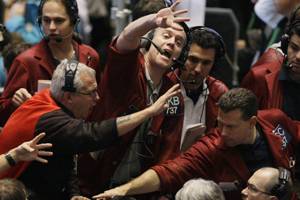Fed slashes interest rates, but stocks lose again

Traders Russel Boose, center, Richard Felman, left, and Michael Carusiello, far right, work in the Eurodollar trading pit Wednesday, Oct. 8, 2008, at the CME Group in Chicago. (AP Photo/M. Spencer Green)
October 7, 2008
WASHINGTON (AP) — Wall Street bounced higher and lower Wednesday trying to make up its mind about an unprecedented coordinated interest rate cut by central banks around the world. In the end it settled on a familiar feeling — fear — and plunged again.
The Federal Reserve, desperately trying to jump-start the lending that keeps the U.S. economy moving, dropped its closely watched federal funds rate to 1.5 percent. The cut from 2 percent took the rate to its lowest level in more than four years.
Central banks in England, China, Canada, Sweden and Switzerland and the European Central Bank also cut rates after a series of high-stakes phone calls over several days between Fed Chairman Ben Bernanke and his counterparts.
But the Dow Jones industrial average lost another 189 points, or 2 percent, to close at 9,258. It was the sixth straight day of losses for the Dow. The index has shed more than a third of its value, nearly 5,000 points, since its all-time high, set one year ago Thursday.
The day’s losses were lighter for the Nasdaq composite index and the Standard & Poor’s 500. And Wall Street as a whole fared far better than Asia, where some stock exchanges were down 9 percent, and Europe, where some lost 5 percent.
The Fed in concert with the European Central Bank to make emergency interest rate cuts after the Sept. 11 terror attacks in 2001. But Wednesday’s cuts were unprecedented with the number of nations that participated, the Fed said.
For millions of Americans, the Fed’s cut means borrowing money becomes cheaper. Home equity loans, credit cards and other floating-rate loans all fluctuate depending on what the Fed does.
Bank of America, Wells Fargo and other banks cut their prime rate by half a point to 4.5 percent, also the lowest in more than four years, after the Fed announced its decision early Wednesday.
Fed watchers believe the central bank might cut rates further when it meets later this month, and perhaps again in December, in hopes of cushioning the blow if the United States falls into recession.
“Even if the financial crisis was put to bed today, that would still leave the economy in a probable recession,” said economist Ken Mayland, president of ClearView Economics.
One day after a presidential debate that focused heavily on the economy, both major candidates embraced the decision. Both Democrat Barack Obama and Republican John McCain described the crisis as global.
The White House welcomed the cooperation among central banks to battle the crisis. “It’s important and helpful that central banks are working in a coordinated way to deal with stress in the financial system,” spokesman Tony Fratto said.
Even the coordinated action may not break the panicky mindset that has gripped investors across the world as jobs evaporate and retirement savings dry up. Banks may still be inclined to hoard cash, and until they decide to lend again the crisis is not likely to let up.
If anyone needed evidence, major American retailers turned in dismal sales figures for the third quarter — further proof that consumer spending, the lifeblood of the economy, is sputtering.
“The turmoil will not end quickly and significant challenges remain ahead,” Treasury Secretary Henry Paulson told reporters at a preview of meetings later this week of the finance officials of the Group of Seven major industrial countries, the 185-nation International Monetary Fund and the World Bank. The global credit crisis was expected to be the major agenda item at those talks.
Paulson spoke after Asian and European markets wrapped up a bleak day, with investors fleeing stocks and worrying that neither the Fed nor other central banks could move fast enough to stop the turmoil, even considering the $700 billion U.S. bailout of financial institutions.
European indexes ended lower, too. Britain’s FTSE-100 finished down about 5.2 percent, Germany’s DAX about 5.9 percent and France’s CAC-40 6.3 percent.
In Asia, where trading ended for the day before the rate cuts were announced, the Japanese Nikkei 225 closed down more than 9 percent, Hong Kong’s Hang Seng more than 8 percent.
In Britain, the government said it would pour cash into troubled banks in exchange for stakes in them — a partial nationalization.
“This is not a time for conventional thinking or outdated dogma but for the fresh and innovative intervention that gets to the heart of the problem,” said Britain’s Prime Minister Gordon Brown.
Sen. Charles Schumer, D-N.Y., suggested the United States take similar steps.
The Fed’s interest rate cut was a change in course. It had held rates steady because of inflation concerns. Since the Fed had put a stop to interest-rate cuts in June, the economic outlook has deteriorated.
“The pace of economic activity has slowed markedly in recent months,” the Fed said. “Moreover, the intensification of financial market turmoil is likely to exert additional restraint on spending, partly by further reducing the ability of households and businesses to obtain credit.”
Although inflation has been running higher, the Fed believes the recent drop in prices for oil and gas, and the weaker prospects for economic activity, have reduced the threat it poses to the economy.
The credit markets, which have been remarkably tight for weeks, showed only small signs of loosening. Rates on commercial paper, the short-term debt companies issue to raise cash for everyday expenses, went down. But the rate banks charge each other for loans went up.
The Fed also reduced its emergency lending rate to banks by half a percentage point, to 1.75 percent. Given the intense credit crisis, banks have been borrowing more under what is known as the discount window.






